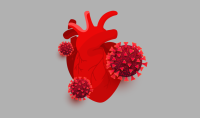What is the impact of coronavirus on the health of young people?

The research findings were published in the journal "Scientific Reports"
Even a mild case of COVID-19 can affect the activity of the autonomic nervous system, also a few weeks after infection – this is the main conclusion from the research carried out by researchers from the Faculty of Physics of the Warsaw University of Technology and doctors from the Hospital of the Ministry of Interior and Administration in Warsaw.
The team set about work in 2020, when the effects of COVID-19, in particular mild and asymptomatic, were still very much unknown. At that time, the first studies focused mainly on severe cases. This is how the idea was conceived - to test the activity of the autonomic nervous system in young people, in good condition and without any accompanying diseases 4-6 weeks after getting infected with SARS-CoV-2. To test and then to compare the results with the control group that was not ill.
First of all – to examine
Approximately 100 men aged 20-25 participated in the study. Students from the Main School of Fire Service in Warsaw were selected for the study group, where there had been a recent outbreak of infections, and students from other Warsaw universities were selected to make up the control group.
– Each of the participants underwent a set of tests, including a 24-hour Holter test, which can be used to analyze heart rate variability – says Mateusz Soliński, PhD, from the Faculty of Physics at the WUT. – By analyzing this variability, we can obtain information about the activity of the autonomic nervous system, that is, that part of it over which we do not have direct control.
The autonomic nervous system is divided into two branches: parasympathetic, activated during rest and relaxation, and sympathetic, whose activity increases when we are in a state of agitation and stress. A change in the balance between the two branches also occurs during diseases and inflammations caused by viral and bacterial infections. This causes a disturbance in the body's homeostasis, i.e. the balance of biological processes, when the body tries to adapt to changes in physiology due to the presence of the pathogen. It usually makes us feel uncomfortable, and the body uses more energy resources to be able to function in an unbalanced state. It is the autonomic nervous system that plays a key role in this process.
Non-typical methods
To study the variability of heart rhythm, researchers from the WUT and doctors from the Ministry of Interior and Administration used a number of mathematical methods of signal analysis – from the simplest, such as the arithmetic mean or standard deviation, to really complex non-linear methods.
– It is the non-linear methods, which are not very frequently used in clinical practice, that revealed subtle but statistically significant differences between the study group and the control group – says Mateusz Soliński, PhD. – This is the case because these methods touch on the problems of complexity and effects that cannot be seen with the naked eye, analyzing the signal graphs. An amazing feature of the RR time series (i.e. the set of time distances between the R wavelets determined in the ECG signal), which we used for the analysis, is that they have multifractal properties (it is a self-similar signal, i.e. one whose parts are similar to the whole). It turns out that it was the methods analyzing multifractality that indicated differences between the compared groups. Additionally, we also noticed a significant difference in the average number of RR intervals per breath.
So what follows from that?
The results obtained by the researchers show that coronavirus infection, even when the symptoms are quite mild or nonexistent, has not been without impact on the body's functioning.
– In convalescents, we have observed changes in the coupling of heart and respiratory rhythms and higher activity of the parasympathetic system – explains Mateusz Soliński, PhD. – We assume that this may be related to pulmonary circulation disorders in people with COVID-19. This circulation is responsible for transporting blood from the heart to the lungs and oxygenating it.
The results and conclusions of the study may be valuable for doctors, researchers and patients themselves, who have been infected with SARS-CoV-2. Physicians are provided with further evidence that the analysis of heart rate variability is a valuable tool for non-invasive monitoring of the patient's health and can be used in clinical practice.
Researchers are gaining new knowledge about changes in the autonomic nervous system and the potential of non-linear methods of signal analysis. Patients, on the other hand, can broaden their awareness of the consequences of infection.
You can read more about the results in the article “Heart rate variability comparison between young males after 4–6 weeks from the end of SARS‑CoV‑2 infection and controls”, published in the prestigious journal "Scientific Reports".
The authors of the publication are researchers from the Faculty of Physics of the Warsaw University of Technology: Mateusz Soliński, PhD, Monika Petelczyc, PhD, Teodor Buchner, PhD, Joanna Aftyka, MSc., prof. Jan Jacek Żebrowski, PhD, and doctors from the Hospital of the Ministry of Interior and Administration in Warsaw: prof. Agnieszka Pawlak, prof. Robert Gil, prof. Zbigniew J. Król.






